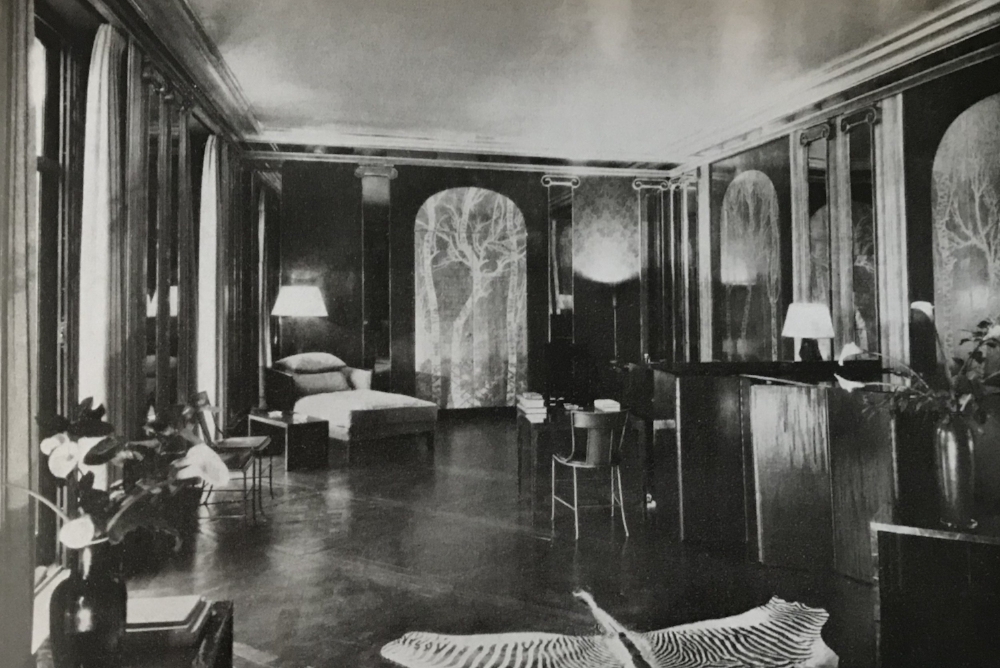jean-michel frank.
jean-michel frank: a very french love affair
We moved to a new apartment in Clinton Hill, Brooklyn just before the end of last year. As lovers of spaces and their possibilities, Quy and I have been like two kids in a candy store - kids with no supervision and a world of possibilities, but with only a fistful of change and endless tough decisions between one piece and another. That said, in all our planning and dreaming, it’s safe to say that no one designer has been occupying our minds more than Jean-Michel Frank. By now we refer to him almost as an old friend - the kind of friend you’ve known for so long that you forget how you first met.
There is an elegant strangeness and almost childlike sense of scale and proportion which draws us to Frank’s work again and again. His curious placement of furniture within a room, neither perfectly ordered nor symmetrical, is somewhat similar to that of a doll’s house. Large pieces of exquisitely made furniture are off-set by a particularly small pair of sconces; a single, decisively placed vase resting on a mantle. Luxury materials such as shagreen, parchment and Hèrmes leather sit alongside plaster, terra cotta, jute, plywood and imitation leather, not following any rules or expectations.
One of our favorite Jean-Michel Frank designed apartments, the apartment of Cole Porter, circa 1928. Silver lacquer paneling above by Armand-Albert Rateau.
“There is an elegant strangeness and almost childlike sense of scale and proportion which draws us to Frank’s work again and again”
Against the general direction of that time, Frank was an advocate for combining different styles, bringing together old and new to create a space both minimal and full. While he eliminated anything superfluous in his interiors, Frank created a mood that couldn’t be further from the hygienic, simplified version of lifestyle that Le Corbusier advocated for. In favor of incorporating pieces of the past, and with a particular penchant for neoclassicism, Frank wrote in 1935 that “The noble frames that came to us from the past can receive today's creations. The house that we build now can welcome ancient things of beauty.” Perhaps that is why his interiors remain so modern and relevant - in many ways much more so than modernist interiors of the same period.
Four-paneled screen covered in black stone in an irregular pattern, circa 1930.
Though Frank was untrained, he was able to earn the trust of a few very wealthy friends of prominent social standing who allowed him to transform their homes. Friends with a rare intelligence and natural poise that freed them of the need to loudly announce their presence in the world, including Charles and Marie Laure de Noailles, Nelson A. Rockefeller, Elsa Schiaparelli and the perfumer Guerlain, amongst many others. The technical virtuosity of Adolphe Chanaux, a peerless woodworker and decorative artist with whom Frank began working in 1931, gave free rein to Frank’s imagination in the creation of his furniture, allowing him to work with materials such as gypsum, mica, straw, shagreen and ivory. Alberto Giacometti, with whom Frank collaborated with for over fifteen years on lamps, vases, sconces and many other objects for his homes, called him ‘one of the best designers of the time’.
“Many of Frank’s designs, like the blocky ‘Comfortable’ couch or the glass cube vase, are now such an integral part of our world that his name is no longer attached”
Window display at the Jean-Michel Frank boutique, circa 1935. Dark stained wood lady's desk with plinth legs, chair and basket in woven wicker, the X lamp in metal.
Though it is debated, Frank is widely credited with the creating the Parsons table during a design class while teaching at Parsons in Paris in the 1930’s. He reportedly challenged his students “to design a table so basic that it would retain its integrity whether sheathed in gold leaf, mica, parchment, split straw or painted burlap, or even left robustly unvarnished.” Whether that story is entirely accurate or not, many of Frank’s designs, like the blocky ‘Comfortable’ couch or the glass cube vase, are now such an integral part of our world that his name is no longer attached.
Frank, who suffered from depression and a severe inferiority complex, brought his life to a tragic end when he threw himself from the top of Rockefeller Center in 1941, a refugee desolated by the Nazi occupation of France. While his fame in his own lifetime was never even nearly as universal as it has become today, he is now regarded as perhaps the most influential Parisian designer and decorator of the Art Moderne period.
To look upon his pieces - whether originals or the re-issues still created today by Ecart International - it’s easy to see Frank’s subtle genius. Against all better judgement we shipped a three-seat leather Jean-Michel Frank sofa to Brooklyn from Paris, having fallen in love with it on an earlier trip, quickly figuring our the logistics of selling our previous sofa (and several other objects in our apartment!) in order to fund the purchase. The act of manipulating the sofa’s large-scale form into our sixth-floor apartment unscathed was a feat in itself and it remained the only piece of furniture we had for several weeks while we navigated our move (I don’t suppose buying a Jean-Michel Frank sofa prior to close is recommended…) It’s not a statement piece, nor one which many will notice, but for us it’s a first step down what I can only imagine will be a dangerously slippery - albeit aesthetically wonderful - Jean-Michel Frank slope.
Frances Elkins' 1930's library for Mrs Kersey Reed, a tribute to Jean-Michel Frank. In the US, Elkins introduced Frank's furniture and became the exclusive importer of his pieces








